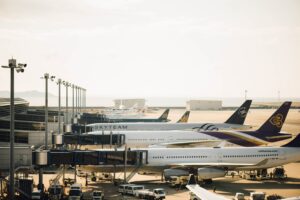As digital transformation gathers pace, what does the future hold for the aviation industry? We discuss the potential of IoT-enabled applications and other connected services across airlines’ operations.
From service automation and mobility services through to the Internet of Things and cloud applications, digital transformation is making its mark on the airline sector. The reason is simple: finding ways to make processes more efficient, whether in the cockpit or on the ground, is part of a critical need to squeeze more value and more efficiency from existing assets.
“Efficiencies can be realised in almost every corner of airline operations thanks to today’s new technologies.”
 Just one example is in connecting pilots and cabin crew using electronic flight bag and electronic passenger lists. This system isn’t simply more convenient – using less paper and adding less weight – it also enables better agility, with near-instant and secure updates, faster filing of flight plans, and more intelligent re-location of passengers in the cabin based on gate priorities and other functions.
Just one example is in connecting pilots and cabin crew using electronic flight bag and electronic passenger lists. This system isn’t simply more convenient – using less paper and adding less weight – it also enables better agility, with near-instant and secure updates, faster filing of flight plans, and more intelligent re-location of passengers in the cabin based on gate priorities and other functions.
Beyond this, standard electronic notebooks can also be used to enhance and accelerate:
- Pilot and cabin crew flight preparation processes
- Customer service and operations – either at the airport or even before passengers arrive at the airport
- Ground crew processes – including flight turnaround and predictive maintenance
Let’s take another example – unplanned maintenance. Aviation businesses can incur huge costs due to the associated time delays. In fact, it is estimated that just two hours of unplanned aircraft maintenance on the tarmac can cost up to $150k (USD). It all adds up to a dramatic impact on operating margins. Not to mention customer satisfaction.
 Unplanned maintenance is a key business area where a proactive, technology-based approach can bring improvements – helping to manage predictive maintenance and avoid technical delays with aircraft. Increasingly, airlines are incorporating effective mobile connectivity capabilities across their global fleet and supply chain – beyond the use of Very Small Aperture Terminal (VSAT) connections.
Unplanned maintenance is a key business area where a proactive, technology-based approach can bring improvements – helping to manage predictive maintenance and avoid technical delays with aircraft. Increasingly, airlines are incorporating effective mobile connectivity capabilities across their global fleet and supply chain – beyond the use of Very Small Aperture Terminal (VSAT) connections.
“There’s no doubt the potential benefits for connected technologies in the aviation sector are vast.”
But achieving productivity boosts and realising efficiencies within existing processes relies on seamless collaboration between airlines and airport authorities. At the heart of this challenge is the need to equip airline staff, airport staff and service partners with ubiquitous access to data and applications.
 A connected air transport ecosystem is centred around automation, using a combination of cellular-enabled mobile connectivity, IoT, AI and Big Data services. But only by combining business strategy with the right technical infrastructure can your organisation successfully achieve new efficiencies. Put simply, implementing successful digital transformation while growing your business globally requires a considered approach to identify and implement best-in-class global connectivity infrastructure and information tools.
A connected air transport ecosystem is centred around automation, using a combination of cellular-enabled mobile connectivity, IoT, AI and Big Data services. But only by combining business strategy with the right technical infrastructure can your organisation successfully achieve new efficiencies. Put simply, implementing successful digital transformation while growing your business globally requires a considered approach to identify and implement best-in-class global connectivity infrastructure and information tools.
“For your airline to achieve successful, borderless growth, scaling the connectivity services that your business needs for its domestic activities is key.”
Yet maintaining cellular asset connectivity – e.g. for consistent aircraft tracking, maintenance information, aircrew allocation and ground crew efficiency management – as your business expands internationally might mean having to negotiate with hundreds of mobile network providers to provide mobile access for your connected crew and connected aircraft applications in each country.
This is a prohibitively complex task, and one better managed through contracting with a single, global provider that can negotiate all the local cellular access agreements on your behalf, while also providing end-to-end mobile and cloud connectivity together with data management services.
The advantages of connected services for pilots, cabin crews and ground staff to achieve greater efficiencies is not the end of the story. Global cellular connectivity also provides opportunities to develop ancillary revenue generation. Upselling in-flight entertainment services might be one area.
“Another interesting way for an airline to generate revenue would be to establish itself as a mobile virtual network operator (MVNO). It’s a logical extension – after all, by definition, your customers are on the move.”
 By offering branded travel SIM services, you can enhance loyalty among your frequent flyers – for example, with a contracted global SIM card. Some airlines are already offering prepaid SIM cards in-flight, however, the MVNO proposition is about offering a richer mobile communications experience, with regular contracted services. This approach can yield profitable revenue as well as building loyalty among your regular travellers. Ultimately, enhancing the passenger experience contributes towards broader goals associated with business efficiency and reputation.
By offering branded travel SIM services, you can enhance loyalty among your frequent flyers – for example, with a contracted global SIM card. Some airlines are already offering prepaid SIM cards in-flight, however, the MVNO proposition is about offering a richer mobile communications experience, with regular contracted services. This approach can yield profitable revenue as well as building loyalty among your regular travellers. Ultimately, enhancing the passenger experience contributes towards broader goals associated with business efficiency and reputation.
It’s clear that an aligned approach to digital transformation not only has the potential to enhance productivity, boost efficiency and earn extra revenue, but can enhance both your partners’ and customers’ experience of your business.
Discover how India’s car manufacturing industry is preparing for cross border connectivity in our previous blog.
Transformational Hybrid SolutionsOur cloud-enablement services offer the best performance on your traffic-heavy websites or mission-critical applications.
Core NetworksTata Communications™ global IT infrastructure and fibre network delivers the resources you need, when and where you need them.
Network Resources
Unified Communications As A ServiceBreak the barriers of borders efficiently and increase productivity with Tata Communications’ UC&C solutions.
Global SIP ConnectEmpower your business with our SIP network and witness it grow exponentially.
InstaCC™ - Contact Centre As A ServiceCloud contact centre solutions for digital customers experience and agent productivity.
DIGO – Communications Platform as a ServiceDIGO is an in-network cloud communications platform, enabling you to power up converged contextual human-to-everything conversations globally.
Unified Communication Resources Case studies, industry papers and other interesting content to help you explore our unified communications solution better.
IoT SolutionsThe Internet of Things is transforming the way we experience the world around us for good. Find out more about our Internet Of Things related solutions here.
Mobility SolutionsTata Communications’ mobility services enable your enterprise to maintain seamless communication across borders, with complete visibility of cost and usage.
Mobility & IoT Resources
Multi-Cloud SolutionsWith enterprises transitioning to a hybrid multi-cloud infrastructure, getting the right deployment model that yields ROI can be a daunting task.
Cloud ComplianceCompliant with data privacy standards across different countries and is also designed to protect customers’ privacy at all levels.
IZO™ Cloud Platform & ServicesIZO™ is a flexible, one-stop cloud enablement platform designed to help you navigate complexity for more agile business performance.
Managed Infrastructure ServicesIntegrated with our integrated Tier-1 network to help your business grow efficiently across borders.
Cloud PartnersWe support a global ecosystem for seamless, secure connectivity to multiple solutions through a single provider.
Cloud Resources
Governance, Risk, and ComplianceRisk and Threat management services to reduce security thefts across your business and improve overall efficiencies and costs.
Cloud SecurityBest-in-class security by our global secure web gateway helps provide visibility and control of users inside and outside the office.
Threat Management - SOCIndustry-leading threat-management service to minimise risk, with an efficient global solution against emerging security breaches and attacks.
Advanced Network SecurityManaged security services for a predictive and proactive range of solutions, driving visibility and context to prevent attacks.
Cyber Security ResourcesCase studies, industry papers and other interesting content to help you explore our securtiy solution better.
Hosted & Managed ServicesTata Communications provide new models for efficient wholesale carrier voice service management. With our managed hosting services make your voice business more efficient and better protected
Wholesale Voice Transport & Termination ServicesYour long-distance international voice traffic is in good hands. End-to-end, voice access & carrier services which includes voice transport and termination with a trusted, global partner.
Voice Access ServicesTata Communication’s provide solutions which take care of your carrier & voice services, from conferencing to call centre or business support applications.
Carrier Services Resources
CDN Acceleration ServicesOur CDN Web Site Acceleration (WSA) solution helps deliver static and dynamic content, guaranteeing higher performance for your website.
CDN SecuritySafeguard your website data and customers’ information by securing your website from hacks and other mala fide cyber activities.
Video CDNDeliver high-quality video content to your customers across platforms – website, app and OTT delivery.
CDN Resources
Elevate CXIncrease customer satisfaction while empowering your service team to deliver world-class customer experience and engagement.
Live Event ServicesTata Communications’ live event services help battle the share if eyeballs as on-demand video drives an explosion of diverse content available on tap for a global audience.
Media Cloud Infrastructure ServicesTata Communications’ media cloud infrastructure offers flexible storage & compute services to build custom media applications.
Global Media NetworkTata Communications’ global media network combines our expertise as a global tier-1 connectivity provider with our end-to-end media ecosystem.
Use CasesUse cases of Tata Communications’ Media Entertainment Services
Remote Production SolutionsMedia contribution, preparation and distribution are highly capital-intensive for producers of live TV and video content, and their workflows are complex.
Media Cloud Ecosystem SolutionsThe Tata Communications media cloud infrastructure services offer the basic building blocks for a cloud infrastructure-as-a-service.
Global Contribution & Distribution SolutionsTata Communications’ global contribution and distribution solution is built to reduce capital outlay and grow global footprint.
Satellite Alternative SolutionsAs more and more consumers choose to cut the cord & switch to internet-based entertainment options, broadcasters are faced with capital allocation decisions.
LeadershipA look into the pillars of Tata communications who carry the torch and are living embodiment of Tata’s values and ethos.
Culture & DiversityHere at Tata Communications we are committed to creating a culture of openness, curiosity and learning. We also believe in driving an extra mile to recognize new talent and cultivate skills.
OfficesA list of Tata Communications office locations worldwide.
SustainabilityTata Communications adopts a holistic approach and harnesses the power of new-age technologies like 5G, IoT and AI to build a sustainable digital world.
FAQCheck out our FAQs section for more information.
BoardHave a look at our board of members.
ResultsFind out more about our quarterly results.
Investor PresentationsFollow our repository of investor presentations.
FilingsGet all information regarding filings of Tata communications in one place.
Investor EventsAll investor related event schedule and information at one place.
GovernanceAt Tata, we believe in following our corporate social responsibility which is why we have set up a team for corporate governance.
SharesGet a better understanding of our shares, dividends etc.
SupportGet all investor related contact information here.



